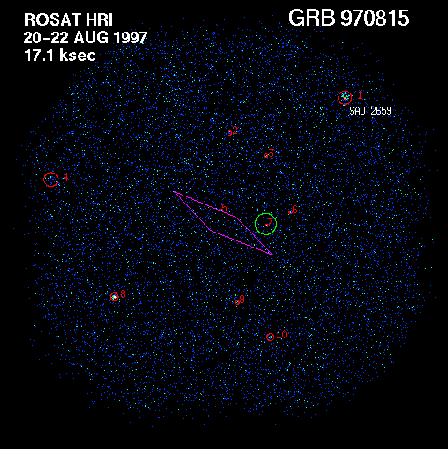
Gamma-ray Burst 970815

A bright Gamma-Ray Burst was detected with BATSE on August 15, 1997 at
12:07:04.41 (15.5049 UT) at R.A. = 241.83, Decl. = +82.99 degrees.
Due to its high ecliptic latitude this GRB was seen in the RXTE all-sky
monitor (IAUC 6718): The burst rise was detected in one
camera on Aug. 15.50597. At Aug. 15.50623, the cameras were
rotated through 6 deg, such that the burst came into the field-of-
view of a second camera. Observations with two cameras at
different orientations enabled an accurate position (see below). The
burst lasted about 130 s and showed a double-peaked structure,
reaching a maximum intensity of almost 2 Crab (2-12 keV) in the
second peak.
 Previous IAU Circulars
Previous IAU Circulars
- IAUC
6718 Location with ASM/RXTE
- IAUC
6721 Optical imaging: no variable down to R = 21.
- IAUC
6722 ASCA finds no X-ray source in ASM error box above 1x10E-13 erg/cm^2/s
(2-10 keV)
- IAUC
6723 no opt. variable > 0.25 mag for V < 21.5; > 0.5 mag for I < 24-24.5;
no radio source
- IAUC
6725 no opt. variable > 0.4 mag brighter than R = 19.0 and I = 19.5
on Aug. 17.2 and 27.2
- IAUC
6742 ROSAT source at RXTE error box border (see image below)
- IAUC
6744 upper limits for optical source within ROSAT error circle:
Aug. 17, K' > 18; Aug. 20, B > 21.5, R > 22; Aug. 23, B > 22.5, R > 23.
 Results of Observations
Results of Observations
- The RXTE/ASM scanning observations have reduced the GRB error box
to less than 10 arcmin: The error box has the following corners:
R.A. = 16h06m36s, Decl. = +81o27'36"; 16h10m50s, +81o33'36";
16h08m10s, +81o31'12"; 16h09m17s, +81o30'00" (equinox 2000.0).
- The image of the 17.1 ksec ROSAT HRI observation with the RXTE error
box overplotted. Red circles with numbers are X-ray sources with more than
3sigma confidence, and the green circle denotes the source detected by ASCA
(IAUC 6722).

- A number of optical images and lightcurves are available on
Feng Ma's
GRB 970815 page
- astroph/0410616 - Mirabal et al.: The X-ray afterglow of dark GRB 970815:
A common origin for GRBs and XRFs?
Chandra pointings reveals that the ASCA/ROSAT source slightly outside
the ASM error box has faded away by a factor of approx. 100.
No optical counterpart for this X-ray source down
to V > 25.2 on July 12, 2004.
The authors therefore suggest this X-ray source to be the X-ray afterglow.
- GCN notice #2837
A. Soderberg, G. Djorgovski (Caltech), J.P. Halpern (Columbia), and N. Mirabal
(U. Michigan) report:
"Following the belated identification of the X-ray afterglow associated with
GRB 970815 (Mirabal et al., astro-ph/0410616), we re-examined our optical
images at this location. Within the ROSAT HRI error circle, a point source
is clearly detected in our I-band images (IAUC 6723) taken on 1997 Aug 18.15 UT
(Palomar 60-inch) and Aug 20.28 UT (Keck II-LRIS), with approximate magnitudes
of I = 22.1 +/- 0.1 and I = 22.3 +/- 0.1, respectively. The source position is
RA 16:06:53.12, Dec +81:30:28.5 (J2000)
with an uncertainty of ~0.5 arcsec in each coordinate. In comparison, an
I-band image taken on 2002 Aug 27 UT with the MDM 2.4-m shows that the
afterglow has since faded below I > 24. It is also fainter than V > 25.2
on 2004 July 12 UT (Mirabal et al., ref above).
The effective spectral index between the I-band and the contemporaneous 2
keV X-ray flux measured by ASCA on 1997 Aug 18.7-19.9 UT is beta_ox = 0.6
+/- 0.1, which is consistent with the ASCA spectral index beta_x = 0.64
+/- 0.35. This beta_ox is on the border line of those bursts that are
considered optically normal, e.g., de Pasquale et al. 2003, ApJ, 592,
1018, or Jakobsson et al. 2004, ApJ, 617, L21. Therefore, GRB 970815 may
not have been dark as assumed by Mirabal et al.. Re-analysis of any other
optical observations of this event would be of interest."
Back to JG's
homepage
Jochen Greiner, last update: 03-Dec-2004
[Disclaimer]
![]() Previous IAU Circulars
Previous IAU Circulars 